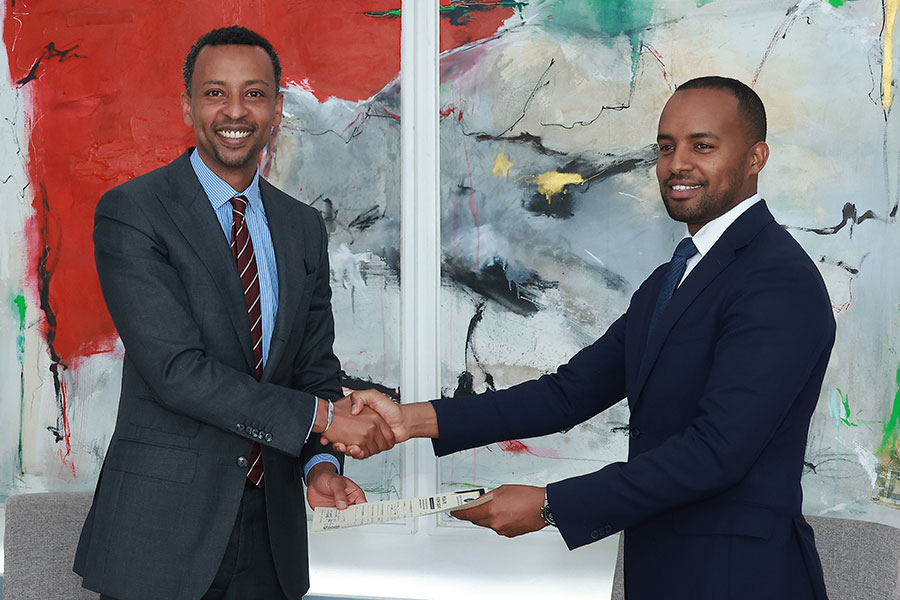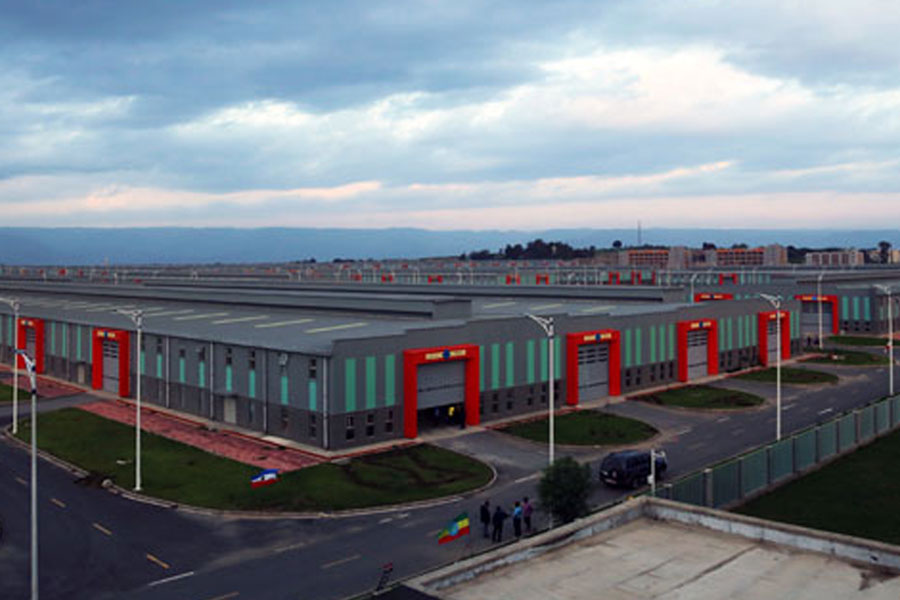
It was a freezing rainy day last week; the loud music and busy sidewalks in the Piassa area were in stark contrast to the exceptionally chilly weather that has gripped Addis Abeba this rainy season. Uncommonly dense fog and bitterly cold weather have been the norm in the capital over the last few weeks, leaving residents huddled indoors and giving the city an eerie feel.
One of these residents, Tezera Bekele, 42, working in the civil service, was leaving a clothing store behind Cinema Empire, wearing a surly expression on his face. He was in the market looking for warm clothing, following a doctor's recommendation in an attempt to alleviate the recurrent sinus infections he suffers from.
"Heavy antibiotics are no longer working," he said. "I was miserable. The doctor suggested wearing warmer clothing to help soothe the infections."
Working with a budget, he hoped to find something cosy at the stores in Piassa. He was only disappointed to find winter jackets going for 2,500 Br on average while a pair of boots sold for as much as 3,000 Br. He walked out, unable to afford to pay that much and calling the prices "exaggerated."
The going prices were so far out of the reach of his 12,000 Br gross salary that he is already unsure how he will be able to get his two sons new clothes and shoes for when school reopens in September.
"The price of a single jacket is almost half my net income," said Tezera.
Tezera was not the only customer turning back upon hearing shop owners name their prices, which have doubled in recent months. Business is painfully slow, according to Yetenayet Abera, who owns one of the clothing shops behind Cinema Empire.
"It's foggy like the weather," she said.
Yetenayet saw when traffic to the area died down, and if she does manage to get a walk-in customer, they often walk right back out upon hearing how much her goods sell for. It is undoubtedly a manifestation of the unrelenting inflation that has gripped the country. Headline inflation hit a decade high of 26.4pc last month, according to the Central Statistics Agency, a federal agency that surveys the movement of prices for goods and services.
Consumer attitudes towards locally manufactured items, such as leather shoes, have been improving. However, manufacturers are struggling to keep up with demand due to issues with foreign currency and raw materials.
However, there are other reasons behind the surge in prices. The central bank's policies on forex management and travel restrictions have all led to the drop in the volume of clothing brought to the country, whether through formal or informal channels. Supply has been disrupted.
"The clothes on our mannequins are all from last year's stock," said Yetenayet.
Clothing made up almost 10pc of the country's four billion dollars worth of imports of consumer goods last year, according to data from Cepheus Capital, a private equity firm conducting macroeconomic analysis. The majority of this is brought in from China, the world's leading textile manufacturer. However, the figures do not account for the informal import of clothing from places like the United Arab Emirates (UAE) and Turkey.
Since the early 2000s, traders have been bringing in clothing informally as baggage on private travels. Individuals travel to these countries on commercial flights; upon their return, their luggage is filled with articles of clothing, shoes, fragrance and cosmetic items their customers in stores and boutiques are interested in buying. However, the onset of the COVID-19 pandemic has greatly limited these hole-and-corner activities.
Strict travel restrictions, particularly to the UAE, abound, fewer people are making the trips. And when they do, there are extra costs involved for COVID-19 testing and, in some cases, quarantine. Unreliable test results before departure sometimes subject travellers to quarantine in a hotel once they have arrived at their destination – at their own expense.
They spend their entire budget on the hotel and return empty-handed, observed Eyouel Assefa, who has seen business slowing down at his travel agency since much of their customer-base were traders, flying mainly to Dubai to stock up.
This is a practice government officials want to see stop completely.
The Customs Commission is conducting research to adjust tariffs, discouraging these informal imports, particularly for clothing and electronic devices.
According to individuals involved in the trade, the foreign currency crunch combined with the central bank's new policies on the use of diaspora accounts is to blame for limiting clothing supply. Officials at the National Bank of Ethiopia (NBE) passed a directive earlier this year compelling diaspora account holders to surrender 30pc of their deposit in foreign exchange while limiting them to the imports of essential items such as pharmaceuticals and agricultural inputs. Clothing does not make it on the list.
Instead of buying the forex on the parallel market or exchanging at banks, importers often rely on residents overseas to provide them with the foreign currency, paying their relatives here with Birr in exchange. Kidist Desalegn is an importer with a retail store in the Haya Hulet neighbourhood who finds the workaround of sourcing forex from Ethiopians abroad getting difficult. The Birr's depreciation against foreign currencies and skyrocketing prices on the parallel market have not helped her. The UAE Dirham now goes for 22 Br on the parallel market, while the Dollar sells for 70 Br.
"It's almost double what it was a few months ago," Kidist said.
The slowing trend in business is not confined to areas such as Piassa or Haya Hulet. Traders in Mercato echo the sentiment that the volume of clothing items coming into the market has fallen sharply. Nonetheless, their stocks are far from running dry; they see demand has fallen as well. Though goods are often cheaper in Mercato than anywhere in the city, the same cannot be said about clothing. A jacket that would have gone for 1,000 Br last year now sells for nearly twice as much. The same is true for cotton sweaters, which are on sale for 1,500 Br. For ladies having below 2,000 Br budget, buying a pair of boots is unthinkable.
Retailers say customers are reluctant to spend on clothing, choosing instead to make do with what they already have in their closets.
With only a third of the country's population earning above 1.5 dollars a day, the poverty line, fulfilling seasonal clothing needs is nothing but a luxury, at least for observers, including Wasihun Belay, an economist. The ballooning prices for clothing are not a primary concern; it is less important than the other two basic needs – food and housing, according to the economist.
"People can buy cheaper clothes from thrift shops or street vendors," he said.
It appears the same applies to Tezera.
"I'm going to try my luck at thrift shops," he told Fortune.
Despite the volatile nature of the market, retailers are still buying items from wholesalers, believing it to be a wiser move than sitting on cash.
Ahmed Mustafa, a retailer in Marcato, hopes customers will eventually adapt to the new prices and demand normalise.
"I'll sell my stock slowly once everyone has adapted to the market price," he said, though barely a month remains before the rainy season ends. "It's been volatile and unstable over these past couple of months."
Prices of imported shoes have also climbed in recent months, pushing users to shift towards embracing domestic products. The slump in imports may present an opportunity for domestic manufacturers.
Cottex is a domestic clothing plant, which employs 400 people. It is, however, unable to take advantage of the opportunity, struggling to get the raw materials it needs for production. Cotton, in particular, has been an issue after recent floods destroyed crops in Afar and Southern regional states, its main sources of supply.
Cottex has had to turn to imports, driving up costs, according to Dilnesaw Nibret, general manager at Cottex.
"Consumer attitudes with local products have changed for the better," said Dilnesaw. "The demand and the purchasing power are there, but we're struggling to keep up."
Demand for domestically made shoes is rising, but there needs to be more work done to convince customers to go local when shopping for apparel. The price of a single pair of men's leather shoes now goes for around 1,000 Br.
Nonetheless, even with the apparent shift in the market, local manufacturers, just like the importers, face significant challenges accessing foreign currency and importing inputs.
Mengistu Lemma Lion Shoe Manufacturing Cooperative is involved in the production of leather shoes. Their managers see the struggle to get forex for the imports of glue and soles as a constant nightmare.
PUBLISHED ON
Aug 07,2021 [ VOL
22 , NO
1110]

Viewpoints | May 20,2023

Commentaries | Mar 07,2020

Radar | Dec 08,2024

Radar | Apr 01,2024

Fortune News | Apr 30,2021

Fortune News | May 08,2021

Radar | Apr 30,2024

Radar | May 13,2023

Radar | Dec 19,2020

Radar | Jan 05,2020

Dec 22 , 2024 . By TIZITA SHEWAFERAW
Charged with transforming colossal state-owned enterprises into modern and competitiv...

Aug 18 , 2024 . By AKSAH ITALO
Although predictable Yonas Zerihun's job in the ride-hailing service is not immune to...

Jul 28 , 2024 . By TIZITA SHEWAFERAW
Unhabitual, perhaps too many, Samuel Gebreyohannes, 38, used to occasionally enjoy a couple of beers at breakfast. However, he recently swit...

Jul 13 , 2024 . By AKSAH ITALO
Investors who rely on tractors, trucks, and field vehicles for commuting, transporting commodities, and f...

Jun 28 , 2025
Meseret Damtie, the assertive auditor general, has never been shy about naming names...

Jun 21 , 2025
A well-worn adage says, “Budget is not destiny, but it is direction.” Examining t...

Jun 14 , 2025
Yet again, the Horn of Africa is bracing for trouble. A region already frayed by wars...

Jun 7 , 2025
Few promises shine brighter in Addis Abeba than the pledge of a roof for every family...